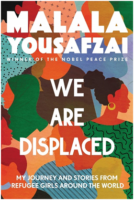Last Updated on November 28, 2022 by themigrationnews

9781474610056, 224 pages.
Introduction
We Are Displaced – My Journey and Stories from Refugee Girls Around the World takes us through the refugee experiences of girls around the world that Malala Yousufzai has met with. Yousufzai and the refugee girls tell a very inspiring story focusing on how they were forced to migrate and seek refuge elsewhere for various reasons. The book was originally published in 2019 and has been republished in 2021 with a new Afterword being written by Yousafzai in October 2020 detailing the events that have taken place since the original publishing.
Summary of the Book
Yousafzai’s book has definitely broken new ground. This is because it is something that other authors have not yet explored much–sharing the journeys of various girls seeking asylum. In effect, the book is written in such a unique way that detailed the refugee experiences. It is a part memoir as Yousafzai provides a very brief account of her story focusing on the experiences of seeking asylum. This provides a background of how her refugee experience made her form the Malala Fund which has enabled her to speak at international forums and meet various refugees of whom some are detailed in this book. The other part of the book is detailed through communal storytelling detailing various refugee journeys the girls have taken. These include stories from Egypt, Syria, Iraq, Italy, Colombia, Zambia, and the United States amongst others. The experiences of people from these countries often get excluded because their experience of fleeing violence such as during the 2015 Syrian Civil War and the more recent Russian Invasion of Ukraine, were not emphasised on the international level. These experiences detail how unforeseen circumstances caused these girls to lose their communities, relatives, and often the only world they have ever known, yet they did not lose hope as they risked their lives by seeking refugee since it was a choice of life or death. The book is also very relevant to the world we currently live in which is constantly filled with immigration crises, wars, and border conflicts. As a result, the book reminds readers how those displaced are ordinary people – often young – who dreams of a better and safer world as they have already lost so much.
Analysis of the Book’s Structure
Yousafzai has essentially organised the structure of her book through two parts. The first part ‘I Am Displaced’ contains six chapters that provide an overview of Yousafzai’s refugee journey. This part details the childhood that Yousafzai spent in Swat Valley, how the Taliban started taking control which caused Yousafzai and her family to become internally displaced persons in Shangla and how Yousafzai became a target upon their return home as she was using her voice to speak out against the Taliban which led to Yousafzai having a near-death experience which led the family to resettle in England. This is an important part of the book as it shows how Yousafzai understands the experiences of these girls as her family had done the same thing years before. The account is very brief which is reflected by the rather short chapters. Yousafzai adds how she does not want to go into the details of her experience in this book as that has already been in her debut autobiographical book – ‘I Am Malala: The Story of the Girl Who Stood Up for Education and was Shot by the Taliban’. In addition, she feels like she does not need to keep dwelling on her past. Instead, she wants to live in the future and focus on the present. Yet, she acknowledges how her story is a part of what led her to meet these people and now wants to shed light on others.
The second part of this book ‘We Are Displaced’ contains eleven chapters detailing the experiences of some refugee girls that Yousafzai has been in touch with throughout the years. Yousafzai begins by stating that these stories began to be heard by her just sitting with these people at refugee camps and letting them tell their stories which she quietly listened to. Each of these chapters has a title page with a map of their home country and neighbouring countries in the background. There is then a box with the girls’ names and the title for that chapter, this is then followed by a listing of the places they have gone to throughout their journey. For example, the first chapter in this part is ‘Zaynab: Why Me and Not Here?’, followed by ‘Yemen à Egypt à United States’. In addition, these chapters also include a brief note from Yousafzai stating how she met them and what her initial thought of their experience was. The chapter then officially begins with the refugee girls such as Zaynab detailing their refugee journeys through the how, what, why, when, and where. The same structure is essentially followed for the remaining ten chapters. In effect, it is hard to go into the details without revealing their stories, reflecting how so much can be learnt from these chapters and Yousafzai’s book as a whole. The epilogue of the book details how Yousafzai visited her childhood home in 2018 and the emotions she felt being lucky enough to experience that. She concludes by stating how her memories and experiences have enabled her to connect with other refugees/displaced persons from around the world. This led to her seeing them, helping them, and essentially sharing some of their stories with the world.
Analysis of Methodology
Throughout the process of writing this book, Yousafzai worked closely with Liz Welch– a journalist and writer. Welch wants readers to understand why certain stories need to be told which inspired her to pick up a career as a collaborator with many people to get their stories heard. This led to Yousafzai and Welch creating We Are Displaced – My Journey and Stories from Refugee Girls Around the World. Yousafzai adds how Welch was the best person to collaborate with as she helped these stories get published and was willing to work whenever needed regardless of whether it was past midnight or not. In essence, the methodology used in constructing this book is oral history. This is because Yousafzai met with these people during her travels and let them share their stories, whilst she would quietly sit and listen to them. In addition, Yousafzai has provided a few pages of photographs in the middle of the book. These photos show the refugee girls who have shared their stories in the books, the meeting Yousafzai and Yousafzai and her family visiting their home in Pakistan years after they had settled in England.
There is no specific intended audience for this book. Regardless, the audience is kept intrigued and hooked throughout to learn the refugee experiences of the girls. This highlights how all refugee journeys are not the same since there are those who have moved through visas, whilst others have faced more risks and tough controls due to them leaving in trucks or by boat. The chapters are worded in ways that make the book an easy read which can easily be finished in one sitting. The book can also be viewed as an introduction to various refugee experiences and can make people want to learn more.
Conclusion
In conclusion, this book highlights the various emotions that people experience throughout their refugee journeys. This includes loss, trauma, resilience, strength, and hope. The book is both devastating and inspiring to read as it empowers readers with all the things that they can achieve throughout their lives. This is because it gets them thinking that if they can do it, then so can I. Therefore, this book is very touching and heartful, which makes it a must-read for all.

Himani Chauhan is an International Relations & History graduate and is currently pursuing Masters of Migration Studies from Victoria University of Wellington (New Zealand). She comes from a family of immigrants which has shaped her experiences, views, and interests in wanting to further explore and work in this area of study. Her area of interest includes – Migration, History, and Human Rights.
